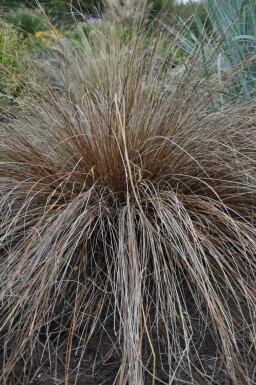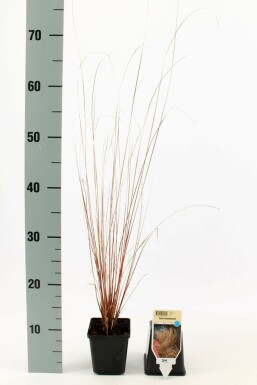

50cm



Welcome to the diverse world of Carex, commonly known as sedge, where an array of species offers a rich tapestry of foliage colors ranging from green to grey, and even variegated patterns with hints of yellow and white. Although Carex is not known for a strong fragrance, what truly distinguishes these plants are their graceful, often arching foliage and the subtle beauty of their brown, red, green, and yellow flowers. Perfect for adding texture and color to your garden, Carex species are versatile and can be used in various landscape designs, providing year-round interest with their enduring foliage.


50cm





45cm










60cm















40cm







70cm






30cm











100cm














40cm






30cm




30cm




Carex, commonly referred to as sedge, encompasses a diverse genus of grass-like plants known for their ornamental foliage and adaptability to a variety of garden settings. Found thriving in a multitude of habitats, the sedge species are incredibly versatile, making them an ideal choice for gardeners looking to add texture and color to their landscape design. With an array of foliage colors that remain vibrant through all seasons, these hardy plants can serve as a striking addition to borders, as group plantings or edge plantings, and are equally effective when planted solitarily or as underplanting in a garden arrangement.
Carex plants are celebrated for their distinctive foliage that comes in a spectrum of colors including brown, orange, green, grey, silver, variegated, white, cream, and yellow. These colors persist throughout the year, transitioning with the seasons to offer a continuously evolving display. Flowering from April to August, Carex produces subtle inflorescences in hues of green, brown, red, and yellow, adding an understated elegance to its grassy clumps.
The sedge genus is appreciated for its adaptability to a wide range of soil types, provided they are well-drained. They can flourish under full sun, partial shade, or even in shaded areas, allowing for diverse placement in any garden. Moreover, these plants have average water needs and are not drought-resistant, necessitating regular watering schedules.
In terms of use, Carex can enhance the visual appeal of garden borders, complement planters with their cascading foliage, and serve as an eye-catching solitary feature or as part of a group planting scheme. Their fruit, which becomes visible in the summer and turns green in the autumn, further contributes to the ornamental value of these plants.
To maintain the vigor and health of your Carex plants, consider propagating them through division in spring or autumn. This process not only stimulates new growth but also helps to prevent overcrowding and ensures the longevity of the plants. When dividing, ensure each part has a good root system and replant them at appropriate distances to allow for adequate growth.
As Carex is not drought-resistant, it is essential to provide consistent watering, especially during dry spells, to keep the soil moist. Avoid overwatering, as sedge prefers well-drained soil to prevent root rot.
When integrating Carex into your garden, be mindful of its growth habit and plant it in areas where it can either spread naturally or be contained if desired. The evergreen, deciduous, or semi-evergreen nature of Carex species means that some will retain their foliage year-round while others may die back and re-emerge with fresh growth in the spring.
Carex is a low-maintenance genus that can bring life and color to your garden throughout the year. With its easy care and stunning foliage, it's an excellent choice for both novice and experienced gardeners alike.
Embrace the understated elegance of the sedge species, a versatile group of perennials that bring a touch of verdant sophistication to any landscape. From the lush, deep hues of the 'Irish Green' to the variegated, frosty stripes of 'Ice Dance', and the striking golden variegation of 'Evergold', these Carex varieties offer texture, color, and year-round interest to gardens and outdoor spaces.
We would like to provide some tips on how to plant and care for a Carex. By following these tips, you can be sure to enjoy your Carex for a long time.
This species thrives in a variety of locations, from full sun to full shade, making it a versatile choice for gardeners. Despite its adaptability, it flourishes best when provided with a well-drained soil environment. While tolerant of different soil types, ensuring proper drainage will promote optimal health and growth. The average water needs of this plant indicate that it should receive consistent moisture, but care should be taken to avoid overwatering. Its diverse foliage colors make it a striking addition to any setting, whether used as a border accent or as a solitary focal point.
For successful establishment, Carex should be planted in well-drained soil, though it will flourish in a diverse range of soil types. This versatility allows it to adapt to various garden designs, from borders to solitary displays. It thrives under full sun to full shade, making it an excellent choice for areas where other plants might struggle. When planting, ensure there is ample space for the sedge to spread its roots. Water moderately post planting to encourage root development. To promote vigorous growth and maintain plant health, division is recommended during the more temperate months of spring or autumn.
To maintain the vibrant foliage and support the growth of Carex, fertilization should be considered a key aspect of its care. A balanced, slow-release fertilizer applied in early spring can promote healthy, lush growth as the growing season commences. This genus, with its diverse array of foliage colors, benefits from the sustained nutrient release, which should coincide with the onset of active growth.
Additional feeding is not typically necessary, given the species' moderate nutritional needs. However, if the growth appears lackluster or the foliage color is not as vibrant as expected, a second application of fertilizer may be applied in mid-summer to rejuvenate the plant and ensure it sustains its vigor throughout the flowering and growing months. Always ensure that the soil remains well-drained and avoid over-fertilization to prevent potential root damage.
Pruning is a minimal requirement for maintaining the vitality and neat appearance of Carex. Trim back the foliage in early spring to remove old, brown leaves and encourage fresh growth. When cutting, simply shape the plant by removing only the tips of dead or unsightly foliage. This gentle approach preserves the plant's natural form and ensures a lush, full appearance throughout the growing season. Regular removal of spent flower stems can also be beneficial, helping to direct the plant's energy into producing vibrant, healthy foliage.
The diverse species within the Carex genus generally have moderate water requirements. To ensure healthy growth and maintain the vibrant foliage colors, it is vital to establish a consistent watering schedule. The soil should be kept evenly moist but not waterlogged, as well-drained conditions are ideal. During periods of high heat or less rainfall, increase the frequency of watering to compensate for the additional moisture loss. Conversely, in cooler or wetter climates, reduce watering to prevent oversaturation of the soil. Monitoring the soil moisture regularly will aid in providing the correct amount of water to support the plant's needs.
Carex species are notable for their adaptability to various soil types, making them versatile choices for landscape design. Their fibrous root systems can help in soil stabilization, especially on slopes or in areas prone to erosion. These hardy plants can provide year-round interest with their evergreen foliage, and the textural contrast they offer is excellent for creating depth in garden compositions. Additionally, their graceful, arching leaves sway beautifully in the breeze, adding movement to serene garden settings.
For healthy proliferation and rejuvenation, division of Carex species is recommended. This process should take place preferably in the cooler months of spring or autumn. Begin by carefully removing the sedge from its location, ensuring that the root ball is intact. Once extracted, divide the clump into smaller sections, each with a sufficient number of roots and shoots. Replant these divisions promptly, ensuring they are placed in well-drained soil and adequately spaced to accommodate future growth. Regular division helps maintain the vigor and aesthetic appeal of these versatile plants.
Discover the timeless grace of Carex, a versatile genus that offers a lush, textural presence in any garden setting. With its elegant foliage that sways gently in the breeze, this plant is a low-maintenance option, ideal for creating an understated yet impactful aesthetic in your landscape.
